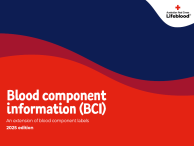Don’t have an account?
Select the donation type you’d like to make
Blood components are derived from blood donations that are separated into cellular and plasma constituents. Each blood component has specific clinical indications, benefits and potential risk.
Some of the common clinical indications for blood components are blood disorders such as iron deficiency anaemia, thrombocytopenia, platelet function disorders, bleeding disorders, and massive haemorrhage.
This clinical transfusion guide provides an up-to-date summary of transfusion practices and adopts the principles of patient blood management (PBM). The National Blood Authority Patient Blood Management Guidelines and other evidenced-based clinical guidelines provide specific decision support regarding appropriate transfusion practices and the use of blood components.
Explore this topic further
Clinical transfusion guidance
Blood disorders
Updated May 2025


